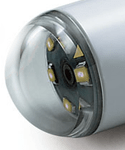Esophagoduodenoscopy is the current gold standard for stratifying risk in patients with gastrointestinal (GI) bleeding, a potentially life-threatening emergency. However, this procedure is performed almost exclusively by gastroenterologists on patients admitted to the hospital. Studies have shown that when esophagoduodenoscopy is performed in the ED, as many as 46% of patients with acute upper GI hemorrhages can be safely discharged home.
Video capsule endoscopy is a recently developed device that may improve care for upper gastrointestinal bleeding. Potential advantages of the device include improved availability, avoidance of sedation, increased patient tolerance, and the ability to rule out active bleeding. Few studies, however, have examined the use of video capsule endoscopy by emergency physicians for suspected acute upper GI bleeding events.
Taking a Deeper Look
In a pilot study published in the Annals of Emergency Medicine, my colleagues and I examined 25 patients with suspected acute upper GI hemorrhage. We compared video capsule endoscopy interpretations of emergency physicians who received a brief training to detect fresh blood or coffee-ground blood. We also wanted to determine if video capsule endoscopy was well tolerated by ED patients and estimate the test characteristics of video capsule endoscopy compared with esophagoduodenoscopy.
In our analysis, there was 92% agreement between gastroenterologists and emergency physicians on test results. Video capsule endoscopy was well tolerated by nearly all patients in the study (96%) and showed sensitivity and specificity rates of 88% and 64%, respectively, for the detection of fresh blood.
Potential Cost Savings
Video capsule endoscopy performed in the ED has the potential to safely allow many patients with GI bleeding to be discharged home for outpatient gastroenterology follow-up instead of being admitted to the hospital, which in turn could save the healthcare system billions of dollars. According to 2011 data, the average hospital stay for patients with GI hemorrhage receiving an esophagoduodenoscopy in the hospital was 4 days, costing nearly $24,000 per patient. By comparison, the national average Medicare fee for video capsule endoscopy is only about $750 per patient.
It should be noted that the cost of purchasing video capsule endoscopy and training personnel on how to use it can be expensive. However, it may prove to be cost-effective if video capsule endoscopy safely reduces hospital admissions or emergency esophagoduodenoscopies. In future research, it will be important to further elucidate the utility of video capsule endoscopy in guiding clinical decision-making and testing its cost-effectiveness in the ED. It will also be important to determine how use of video capsule endoscopy compares with the current standard of care.
Source: Mohammad Khuroo, MD



 admin
admin